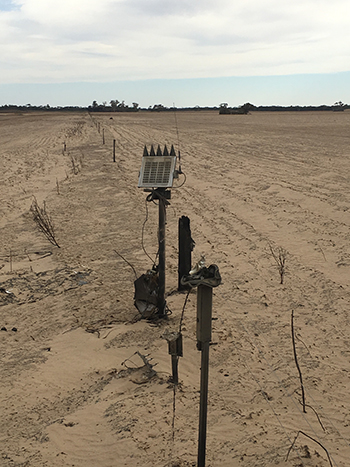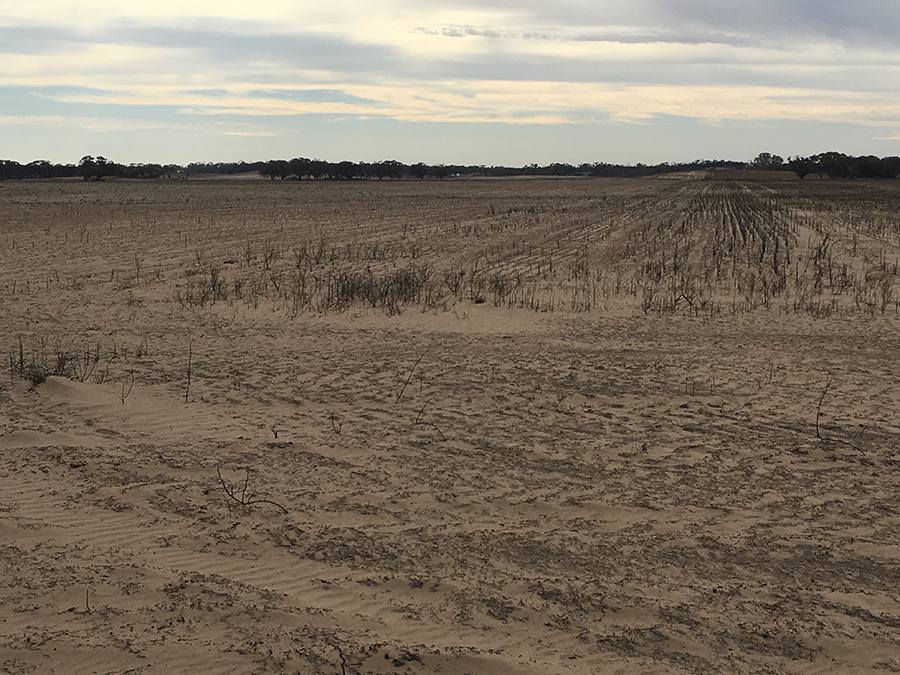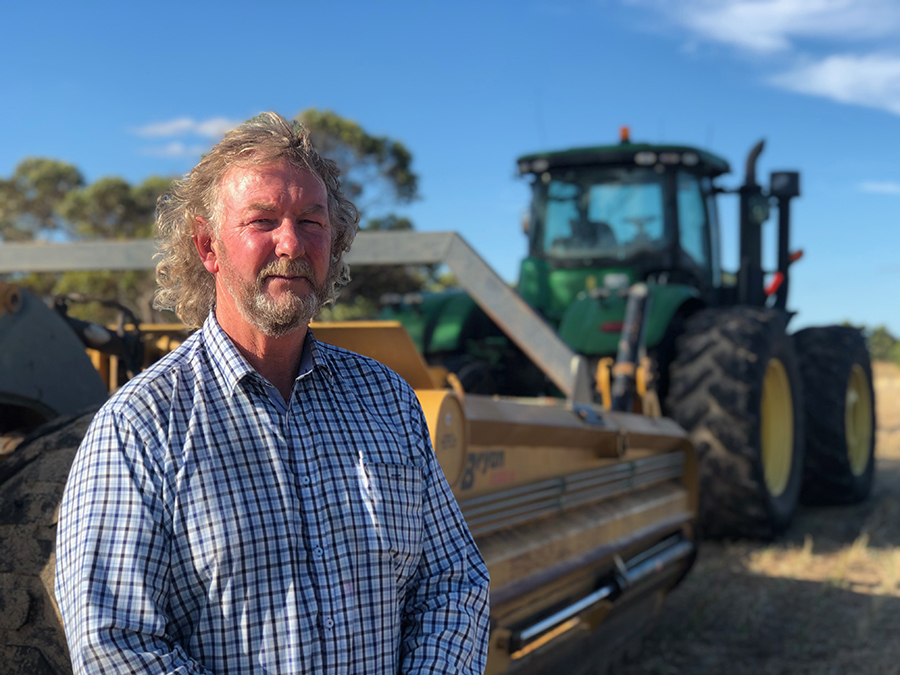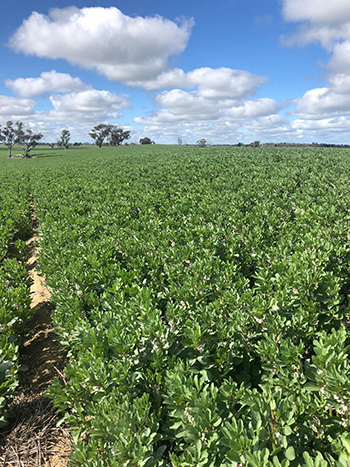 A weather station and fencing damaged by the blaze. Photo: Steve Jaeschke
A weather station and fencing damaged by the blaze. Photo: Steve Jaeschke
Temperatures soared into the high forties and winds reached up to 50 kilometres per hour when fire ravaged the Jaeschke family’s 6500-hectare farm in the districts near Bordertown, South Australia, on 6 January 2018.
“The weather station in one of the paddocks registered 46°C before it melted when the fire reached it,” Steve Jaeschke says.
The blaze destroyed 1618ha of crop stubble, 200ha of standing crop, 85km of fencing (external and internal boundaries), 1000 tonnes of grain in silo bags, 1200 large square hay bales and 150 crossbred lambs. The family homes were spared, but two farmhouses and a shearing shed were lost to the fire that burnt about 13,000ha from north-east of Keith to north of Bordertown.
It is difficult to imagine how the blaze, originating from an electrical fault, might have had a silver lining for the Jaeschkes – Steve, Robynne, Anthony and Jude – who, together with their children, crop 5500ha across properties at Keith, Mundulla and Wolseley.
Yet Steve and his family have turned the adversity of the inferno into an opportunity for intensive soil amelioration works. These works have not only remediated charred paddocks, but also lifted the overall productivity and profitability of their farm business in the past three years since the fire.
Steve says the devastation created an urgent need to rehabilitate sandy soil that had become vulnerable to serious erosion on about 2020ha of burnt country. “It was potentially another disaster if we didn’t take steps to protect the fire-affected soil,” he says.
With imminent danger of the soil being swept away by wind erosion, a Herculean effort saw the exhausted family implement a rigorous program integrating clay spreading, delving, spading and deep ripping.

Burnt non-wetting sands prone to erosion two days after the fire on the Jaeschke family’s ‘Elkanah’ property. Photo: Steve Jaeschke.
‘Never give up’
“We drew fortitude from the ethos – ‘never give up’ – and within a couple of weeks we had five tractors working to arrest erosion in response to the fire,” Steve says.
“Immediately after the fire there was wind and dust like you wouldn’t believe. There were days when contractors returning to the site of paddock earthworks couldn’t tell where they had been working.”
Despite these bleak conditions, the Jaeschkes found consolation in the “clean slate” the fire created when it destroyed the internal fence boundaries of small paddocks traditionally used to hold sheep.
They saw the old fencing infrastructure as obsolete since cropping had become the primary focus of the business. The livestock enterprise is supplementary, with up to 5000 sheep, mainly Merinos and Merino crossbreds, run as an “opportunity enterprise” grazed on stubbles.
“We had to dig thousands of iron fence posts out of the ground and remove truckloads of fencing wire. But the fire damage to the internal fencing gave us the opportunity to reconfigure our paddock layout and, in turn, optimise operational efficiency as part of a large-scale, broadacre cropping system.”
The family’s ‘Elkanah’ property has a 30-year history of clay amendment targeting erosion on sandy soils, in part informed by Steve’s 2004 Nuffield Scholarship exploring approaches to claying in other countries. Clay amelioration can reduce water repellency and increase retention of soil water and nutrients.

Steve Jaeschke with the earthworks machinery used to remediate water-repellent sandy soils. Photo: Elise Jaeschke
Life journey
“Modifying the soil with claying is an ongoing life journey for me in terms of learning and understanding,” he says.
However, the extensive fire damage provided new impetus to intensify and expand the family’s clay amelioration program. Before the fire, a low-intensity claying program was used to gradually renovate sandy areas, such as sand hills, susceptible to erosion. “We generally remediated the areas that needed it the most.” Using this incremental approach, they applied clay to about 3000ha of fragile sandy soils over three decades, averaging 100ha per year.
Since the 2018 fire, however, the Jaeschkes have “shifted the program into top gear”, applying clay on 2000ha of sandy soil, averaging 666ha per year.
The claying program was used to ameliorate 600ha in 2018, 600ha in 2019 and 800ha in 2020.
The overall cost of earthworks combining clay spreading, delving, spading and deep ripping is about $680 per hectare, Steve says.
 Faba beans growing on ameliorated non-wetting sands three years after the fire. Photo: Steve Jaeschke
Faba beans growing on ameliorated non-wetting sands three years after the fire. Photo: Steve Jaeschke
But they have already recouped this outlay, totalling about $1.36 million across 2000ha in the past three seasons.
The return on investment mainly stems from the lift in crop productivity as a consequence of improved soil quality and structure, which promotes increased soil moisture infiltration and plant root growth on clayed country.
The program has also enabled the Jaeschkes to sow wheat on 175ha of rehabilitated soil that was previously unsuitable for growing the crop as part of the farm’s typical rotation: wheat/wheat/faba beans.
“We were able to grow a 3t/ha crop of LRPB Trojan wheat last year on the renovated country where we couldn’t previously grow the crop,” Steve says.
Establishing this three-year crop rotation is an important component of the family’s fire recovery strategy that helps stabilise and revitalise the soil in the seasons following the earthworks.
Wheat crops produce good early vigour and biomass, and provide stubble after harvest which helps protect the soil in the summer following earthworks.
Amelioration earthworks
The Jaeschke family’s ongoing soil amelioration program targeting non-wetting sands has diverse objectives on their SA properties.
These objectives range from reducing erosion and increasing soil moisture and nutrient retention to improving crop germination, weed control and soil organic matter.
Their soil amelioration strategy combines four machinery operations: clay spreading, delving, spading and deep ripping.
The earthworks occur during three months, beginning after harvest in January – ideally, prior to rain – and finishing by April before seeding, Steve Jaeschke says.
Contractors generally use a tractor-towed land plane to dig large pits from which clay is extracted for spreading operations. The pits are typically about 50 metres long and 15m wide, with a depth that varies from three to 8m depending on the clay quality and volume required for spreading.
Steve says the pits are positioned as close as possible to sandy areas that require clay spreading to minimise carting costs and optimise operational efficiency. They aim to source the clay from pits in low-lying paddock areas. These tend to contain quality clay subsoils, he says.
The clay extracted from pits is deposited and left exposed on the paddock surface in 25-tonne loads to dry and crumble for one to four weeks, before being spread over non-wetting sands using a tractor-towed smudging board or railway irons.
The Jaeschkes apply relatively high rates of clay, from 300 to 350t/ha, mainly to arrest the high risk of erosion on water-repellent sands damaged by fire in 2018.

Steve and his family combine clay spreading, delving, spading and deep ripping as part of their soil amelioration program. Photo: Elise Jaeschke
A contractor then uses a spading machine to incorporate the spread clay into the sandy soil to a depth of about 40 centimetres.
This clay spreading approach is used where clay layers occur deep in the soil profile.
But where the clay occurs in relatively shallow layers beneath the sandy topsoil, a delving machine is used to lift the clay to the soil surface because it is more cost-effective than adding clay from pits.
“The clay spreading causes massive disruption to the soil, and these earthworks are alternated with delving on sandy soils that do not require spreading,” Steve says.
He says a contractor also uses the spader to incorporate the clay on the delved areas. Offset discs are then used to further incorporate the clay with deep ripping.
He says the overall cost of the earthworks, totalling about $680/ha, roughly includes $350/ha for clay spreading, $150/ha for delving, $130/ha for spading, and $50/ha for deep ripping using discs.
The operational costs can vary significantly across a paddock depending on whether the clay occurs in deep or shallow layers in the soil profile. For example, there is a $200/ha cost difference between the $350/ha cost of clay spreading to access deep clay layers and the $150/ha cost of delving to access shallow layers.
Steve estimates that, on average, it takes about 1.5 hours to complete the combined amelioration works across one hectare of non-wetting sands.
More information: Steve Jaeschke, 0429 692 300, j.partners@bigpond.com

























































